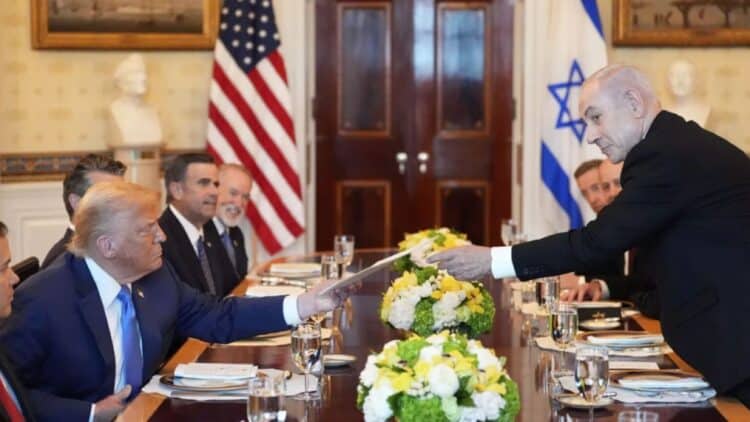Political pressure from Donald Trump played a key role in advancing indirect negotiations between Israel and Hamas in Doha. Both sides have softened their positions and are currently reviewing a U.S.-backed proposal, which includes a 60-day ceasefire and the release of Israeli hostages. The recent meeting between the U.S. President and Israeli Prime Minister Benjamin Netanyahu appears to have facilitated renewed dialogue.
Benjamin Netanyahu lets his guard down
This week, Donald Trump and Benjamin Netanyahu held private meetings in Washington to discuss the ceasefire in the Gaza Strip. The idea of the meeting was to reach a consensus on certain points of the agreement between Israel and Hamas. Due to irreconcilable differences, the Republican leader had to find a middle ground on the conditions to convince the Jewish State and the Palestinian terrorist organization.
The Netanyahu government initially rejected Hamas’ proposal outright. The Palestinian organization demanded three specific points: the withdrawal of Israeli troops from the Gaza Strip, a definitive truce and the return of the UN to control humanitarian aid for the region. None of these items convinced the Jewish State and the truce was again stalled.
However, everything changed after this week’s meetings. Trump’s pressure had an immediate effect on the Jewish prime minister. What did he do to convince him? He offered him a fair deal: the U.S. would continue its political and economic support, in exchange for easing its maximum position vis-à-vis Hamas’ proposals. The talks also took a new route and hope for a truce is growing by leaps and bounds.
The importance of hostages
Hamas has in its hand a very useful card for negotiations: the hostages. Currently, the release of the prisoners is at the top of Benjamin Netanyahu’s agenda. Social pressure from relatives has increased the urgency of reaching an agreement to bring these people home. With this point in its favor, the terrorist organization insists on a definitive truce.
Trump and Witkoff responded to the request of the Palestinian armed movement through Qatar and assured that the U.S. can guarantee the extension of the truce. In exchange, they demand the release of all the prisoners. This would be an abysmal modification of the current truce. Let us recall that so far, there is only agreement to release 10 hostages alive and to return the bodies of 18 people who died in captivity.
Despite the differences of ideas, Hamas agreed very cautiously to continue with indirect negotiations. They could also agree to at least a 60-day truce that would allow them to lower their guard and stop fighting the bombs and the Israeli army. The Palestinians’ decision gives the United States hope and paves the way for a possible agreement before the end of the week.
What will happen to humanitarian aid?
The last point of the negotiation raises changes for humanitarian aid. After hundreds of deaths and irregularities in the distribution of food, Hamas requested the return of the UN to control the resources. It accuses the Gaza Humanitarian Foundation (GHF) of playing for Israel and charges that delivery points function as booby traps for Palestinians.
Trump and Netanyahu did not take kindly to the Palestinian organization’s request, but reached a compromise: the GHF would continue to manage the main areas of Gaza, while the UN would regain control of distribution in the north of the Palestinian enclave. Now, it only remains to wait for the decision of the armed movement to turn the page after Netanyahu’s latest response.

